高中生物新课程中对照实验和对比实验的例谈
- 格式:doc
- 大小:4.34 KB
- 文档页数:3
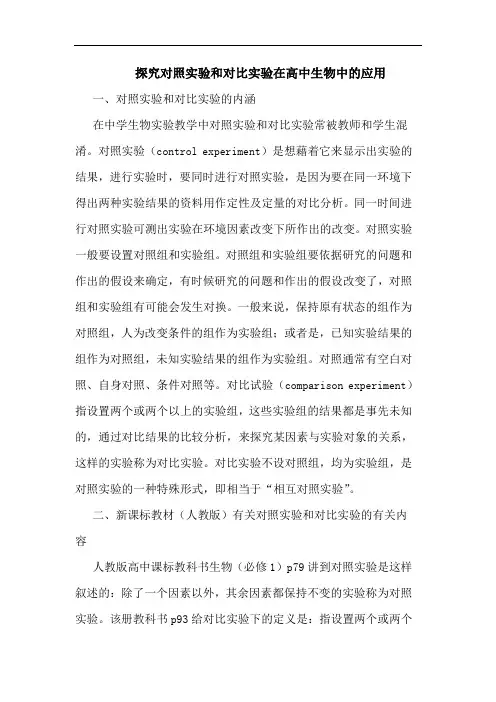
探究对照实验和对比实验在高中生物中的应用一、对照实验和对比实验的内涵在中学生物实验教学中对照实验和对比实验常被教师和学生混淆。
对照实验(control experiment)是想藉着它来显示出实验的结果,进行实验时,要同时进行对照实验,是因为要在同一环境下得出两种实验结果的资料用作定性及定量的对比分析。
同一时间进行对照实验可测出实验在环境因素改变下所作出的改变。
对照实验一般要设置对照组和实验组。
对照组和实验组要依据研究的问题和作出的假设来确定,有时候研究的问题和作出的假设改变了,对照组和实验组有可能会发生对换。
一般来说,保持原有状态的组作为对照组,人为改变条件的组作为实验组;或者是,已知实验结果的组作为对照组,未知实验结果的组作为实验组。
对照通常有空白对照、自身对照、条件对照等。
对比试验(comparison experiment)指设置两个或两个以上的实验组,这些实验组的结果都是事先未知的,通过对比结果的比较分析,来探究某因素与实验对象的关系,这样的实验称为对比实验。
对比实验不设对照组,均为实验组,是对照实验的一种特殊形式,即相当于“相互对照实验”。
二、新课标教材(人教版)有关对照实验和对比实验的有关内容人教版高中课标教科书生物(必修1)p79讲到对照实验是这样叙述的:除了一个因素以外,其余因素都保持不变的实验称为对照实验。
该册教科书p93给对比实验下的定义是:指设置两个或两个以上的实验组,通过对比结果的比较分析,来探究某种因素与实验对象的关系,这样的实验称为对比实验。
我们来总结高中生物必修书中的对照实验和对比实验。
在人教版必修1中有以下实验:实验①“比较过氧化氢在不同条件下的分解”中,1号试管是在常温下只加入过氧化氢溶液,2号试管是加入了过氧化氢溶液并在90 ℃水浴中加热,3号试管是在过氧化氢溶液中加入fecl3溶液,4号试管是在过氧化氢溶液中加入肝脏研磨液。
那么,1号与2号、1号与3号、1号与4号是三组对照实验,其中1号是对?照组,2号、3号、4号是实验组(即1号与3号、1号与4号作为对照实验时,1号中应加入与fecl3溶液或肝脏研磨液等量的蒸馏水);3号与4号是对比实验。
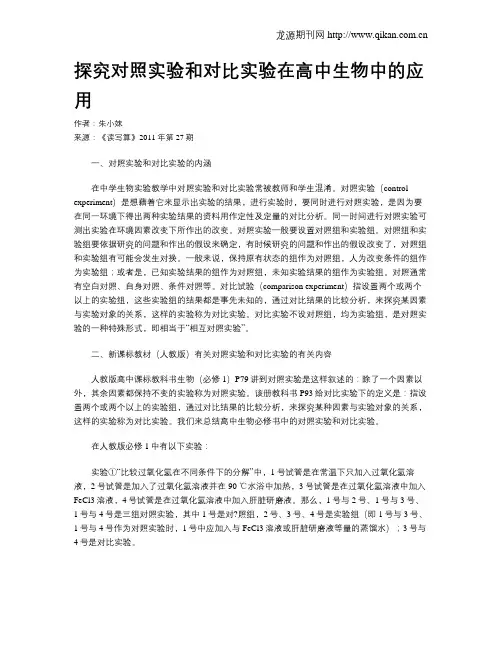
探究对照实验和对比实验在高中生物中的应用作者:朱小妹来源:《读写算》2011年第27期一、对照实验和对比实验的内涵在中学生物实验教学中对照实验和对比实验常被教师和学生混淆。
对照实验(control experiment)是想藉着它来显示出实验的结果,进行实验时,要同时进行对照实验,是因为要在同一环境下得出两种实验结果的资料用作定性及定量的对比分析。
同一时间进行对照实验可测出实验在环境因素改变下所作出的改变。
对照实验一般要设置对照组和实验组。
对照组和实验组要依据研究的问题和作出的假设来确定,有时候研究的问题和作出的假设改变了,对照组和实验组有可能会发生对换。
一般来说,保持原有状态的组作为对照组,人为改变条件的组作为实验组;或者是,已知实验结果的组作为对照组,未知实验结果的组作为实验组。
对照通常有空白对照、自身对照、条件对照等。
对比试验(comparison experiment)指设置两个或两个以上的实验组,这些实验组的结果都是事先未知的,通过对比结果的比较分析,来探究某因素与实验对象的关系,这样的实验称为对比实验。
对比实验不设对照组,均为实验组,是对照实验的一种特殊形式,即相当于“相互对照实验”。
二、新课标教材(人教版)有关对照实验和对比实验的有关内容人教版高中课标教科书生物(必修1)P79讲到对照实验是这样叙述的:除了一个因素以外,其余因素都保持不变的实验称为对照实验。
该册教科书P93给对比实验下的定义是:指设置两个或两个以上的实验组,通过对比结果的比较分析,来探究某种因素与实验对象的关系,这样的实验称为对比实验。
我们来总结高中生物必修书中的对照实验和对比实验。
在人教版必修1中有以下实验:实验①“比较过氧化氢在不同条件下的分解”中,1号试管是在常温下只加入过氧化氢溶液,2号试管是加入了过氧化氢溶液并在90 ℃水浴中加热,3号试管是在过氧化氢溶液中加入FeCl3溶液,4号试管是在过氧化氢溶液中加入肝脏研磨液。
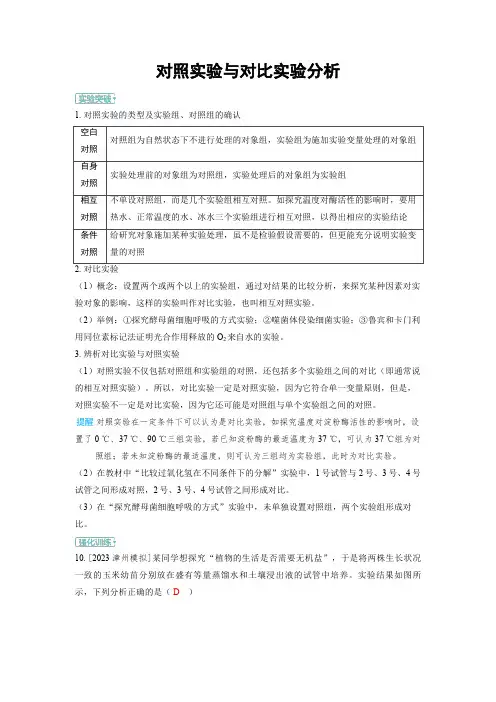
对照实验与对比实验分析1.对照实验的类型及实验组、对照组的确认空白对照对照组为自然状态下不进行处理的对象组,实验组为施加实验变量处理的对象组自身对照实验处理前的对象组为对照组,实验处理后的对象组为实验组相互对照不单设对照组,而是几个实验组相互对照。
如探究温度对酶活性的影响时,要用热水、正常温度的水、冰水三个实验组进行相互对照,以得出相应的实验结论条件对照给研究对象施加某种实验处理,虽不是检验假设需要的,但更能充分说明实验变量的对照2.对比实验(1)概念:设置两个或两个以上的实验组,通过对结果的比较分析,来探究某种因素对实验对象的影响,这样的实验叫作对比实验,也叫相互对照实验。
(2)举例:①探究酵母菌细胞呼吸的方式实验;②噬菌体侵染细菌实验;③鲁宾和卡门利用同位素标记法证明光合作用释放的O2来自水的实验。
3.辨析对比实验与对照实验(1)对照实验不仅包括对照组和实验组的对照,还包括多个实验组之间的对比(即通常说的相互对照实验)。
所以,对比实验一定是对照实验,因为它符合单一变量原则,但是,对照实验不一定是对比实验,因为它还可能是对照组与单个实验组之间的对照。
提醒对照实验在一定条件下可以认为是对比实验,如探究温度对淀粉酶活性的影响时,设置了0℃、37℃、90℃三组实验,若已知淀粉酶的最适温度为37℃,可认为37℃组为对照组;若未知淀粉酶的最适温度,则可认为三组均为实验组,此时为对比实验。
(2)在教材中“比较过氧化氢在不同条件下的分解”实验中,1号试管与2号、3号、4号试管之间形成对照,2号、3号、4号试管之间形成对比。
(3)在“探究酵母菌细胞呼吸的方式”实验中,未单独设置对照组,两个实验组形成对比。
10.[2023漳州模拟]某同学想探究“植物的生活是否需要无机盐”,于是将两株生长状况一致的玉米幼苗分别放在盛有等量蒸馏水和土壤浸出液的试管中培养。
实验结果如图所示,下列分析正确的是(D)A.本实验的自变量为是否提供光照和土壤浸出液B.实验结果说明植物生长需要含氮、磷、钾的无机盐C.试管A中的蒸馏水可以用池塘水或井水代替D.本实验采用的是无土栽培技术,A组和B组形成了对照解析本实验的自变量为是否提供土壤浸出液,光照为无关变量,应保持相同且适宜,A 错误;通过这个实验现象,可以得出的结论是植物的生活需要土壤浸出液中的某些物质,但不能得知植物生长需要含氮、磷、钾的无机盐,B错误;实验中,设计盛蒸馏水的试管A的目的是对照,池塘水或井水含有杂质(可能含无机盐),会影响实验结果,因此试管A中的蒸馏水不可以用池塘水或井水代替,C错误。
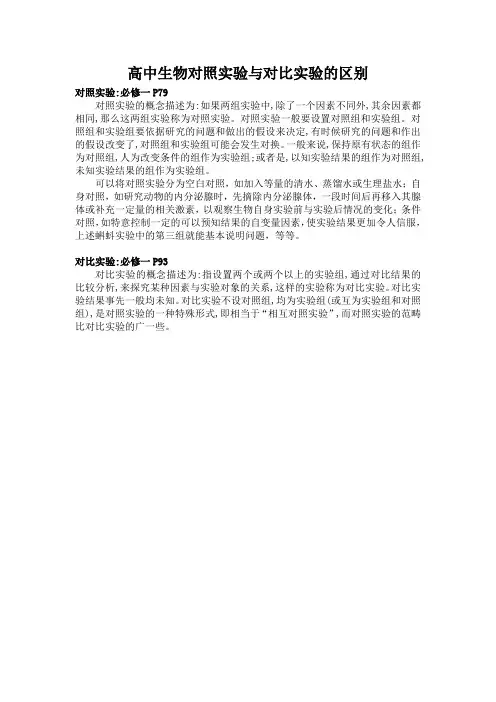
高中生物对照实验与对比实验的区别
对照实验:必修一P79
对照实验的概念描述为:如果两组实验中,除了一个因素不同外,其余因素都相同,那么这两组实验称为对照实验。
对照实验一般要设置对照组和实验组。
对照组和实验组要依据研究的问题和做出的假设来决定,有时候研究的问题和作出的假设改变了,对照组和实验组可能会发生对换。
一般来说,保持原有状态的组作为对照组,人为改变条件的组作为实验组;或者是,以知实验结果的组作为对照组,未知实验结果的组作为实验组。
可以将对照实验分为空白对照,如加入等量的清水、蒸馏水或生理盐水;自身对照,如研究动物的内分泌腺时,先摘除内分泌腺体,一段时间后再移入其腺体或补充一定量的相关激素,以观察生物自身实验前与实验后情况的变化;条件对照,如特意控制一定的可以预知结果的自变量因素,使实验结果更加令人信服,上述蝌蚪实验中的第三组就能基本说明问题,等等。
对比实验:必修一P93
对比实验的概念描述为:指设置两个或两个以上的实验组,通过对比结果的比较分析,来探究某种因素与实验对象的关系,这样的实验称为对比实验。
对比实验结果事先一般均未知。
对比实验不设对照组,均为实验组(或互为实验组和对照组),是对照实验的一种特殊形式,即相当于“相互对照实验”,而对照实验的范畴比对比实验的广一些。
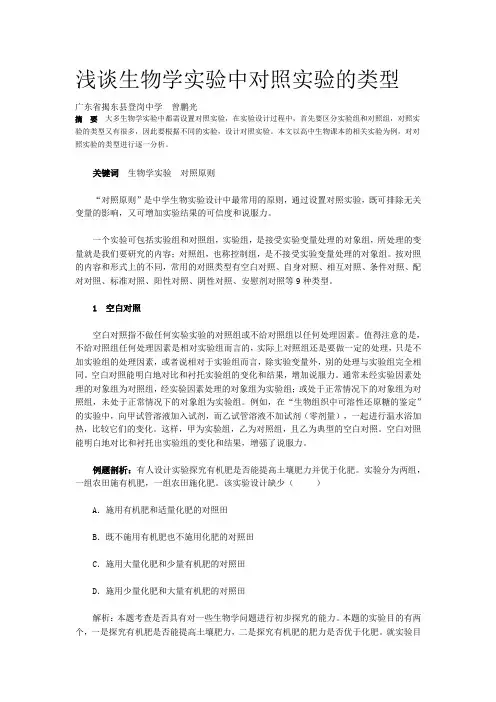
浅谈生物学实验中对照实验的类型广东省揭东县登岗中学曾鹏光摘要大多生物学实验中都需设置对照实验,在实验设计过程中,首先要区分实验组和对照组,对照实验的类型又有很多,因此要根据不同的实验,设计对照实验。
本文以高中生物课本的相关实验为例,对对照实验的类型进行逐一分析。
关键词生物学实验对照原则“对照原则”是中学生物实验设计中最常用的原则,通过设置对照实验,既可排除无关变量的影响,又可增加实验结果的可信度和说服力。
一个实验可包括实验组和对照组,实验组,是接受实验变量处理的对象组,所处理的变量就是我们要研究的内容;对照组,也称控制组,是不接受实验变量处理的对象组。
按对照的内容和形式上的不同,常用的对照类型有空白对照、自身对照、相互对照、条件对照、配对对照、标准对照、阳性对照、阴性对照、安慰剂对照等9种类型。
1 空白对照空白对照指不做任何实验实验的对照组或不给对照组以任何处理因素。
值得注意的是,不给对照组任何处理因素是相对实验组而言的,实际上对照组还是要做一定的处理,只是不加实验组的处理因素,或者说相对于实验组而言,除实验变量外,别的处理与实验组完全相同。
空白对照能明白地对比和衬托实验组的变化和结果,增加说服力。
通常未经实验因素处理的对象组为对照组,经实验因素处理的对象组为实验组;或处于正常情况下的对象组为对照组,未处于正常情况下的对象组为实验组。
例如,在“生物组织中可溶性还原糖的鉴定”的实验中,向甲试管溶液加入试剂,而乙试管溶液不加试剂(零剂量),一起进行温水浴加热,比较它们的变化。
这样,甲为实验组,乙为对照组,且乙为典型的空白对照。
空白对照能明白地对比和衬托出实验组的变化和结果,增强了说服力。
例题剖析:有人设计实验探究有机肥是否能提高土壤肥力并优于化肥。
实验分为两组,一组农田施有机肥,一组农田施化肥。
该实验设计缺少()A.施用有机肥和适量化肥的对照田B.既不施用有机肥也不施用化肥的对照田C.施用大量化肥和少量有机肥的对照田D.施用少量化肥和大量有机肥的对照田解析:本题考查是否具有对一些生物学问题进行初步探究的能力。
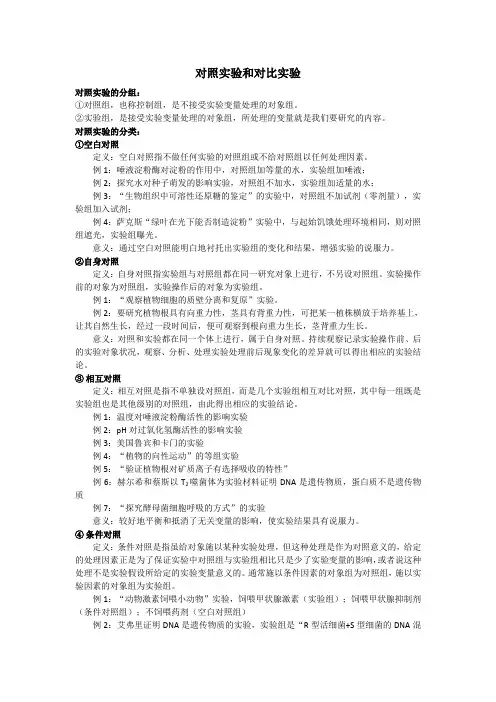
对照实验和对比实验对照实验的分组:①对照组,也称控制组,是不接受实验变量处理的对象组。
②实验组,是接受实验变量处理的对象组,所处理的变量就是我们要研究的内容。
对照实验的分类:①空白对照定义:空白对照指不做任何实验的对照组或不给对照组以任何处理因素。
例1:唾液淀粉酶对淀粉的作用中,对照组加等量的水,实验组加唾液;例2:探究水对种子萌发的影响实验,对照组不加水,实验组加适量的水;例3:“生物组织中可溶性还原糖的鉴定”的实验中,对照组不加试剂(零剂量),实验组加入试剂;例4:萨克斯“绿叶在光下能否制造淀粉”实验中,与起始饥饿处理环境相同,则对照组遮光,实验组曝光。
意义:通过空白对照能明白地衬托出实验组的变化和结果,增强实验的说服力。
②自身对照定义:自身对照指实验组与对照组都在同一研究对象上进行,不另设对照组。
实验操作前的对象为对照组,实验操作后的对象为实验组。
例1:“观察植物细胞的质壁分离和复原”实验。
例2:要研究植物根具有向重力性,茎具有背重力性,可把某一植株横放于培养基上,让其自然生长,经过一段时间后,便可观察到根向重力生长,茎背重力生长。
意义:对照和实验都在同一个体上进行,属于自身对照。
持续观察记录实验操作前、后的实验对象状况,观察、分析、处理实验处理前后现象变化的差异就可以得出相应的实验结论。
③相互对照定义:相互对照是指不单独设对照组,而是几个实验组相互对比对照,其中每一组既是实验组也是其他级别的对照组,由此得出相应的实验结论。
例1:温度对唾液淀粉酶活性的影响实验例2:pH对过氧化氢酶活性的影响实验例3:美国鲁宾和卡门的实验例4:“植物的向性运动”的等组实验例5:“验证植物根对矿质离子有选择吸收的特性”例6:赫尔希和蔡斯以T2噬菌体为实验材料证明DNA是遗传物质,蛋白质不是遗传物质例7:“探究酵母菌细胞呼吸的方式”的实验意义:较好地平衡和抵消了无关变量的影响,使实验结果具有说服力。
④条件对照定义:条件对照是指虽给对象施以某种实验处理,但这种处理是作为对照意义的,给定的处理因素正是为了保证实验中对照组与实验组相比只是少了实验变量的影响,或者说这种处理不是实验假设所给定的实验变量意义的。
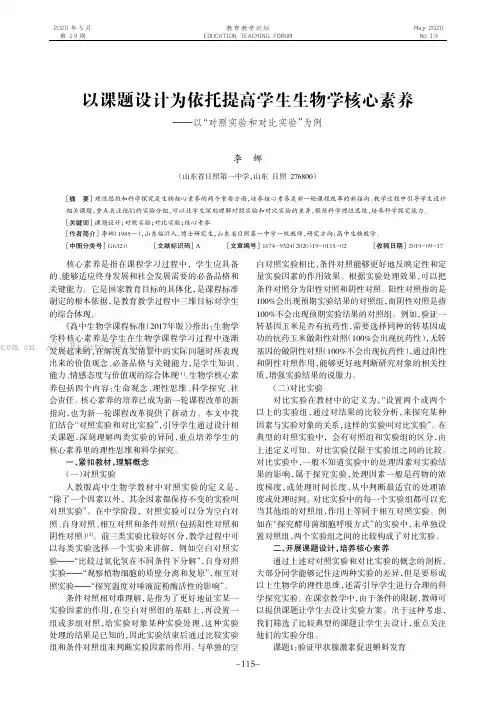
以课题设计为依托提高学生生物学核心素养李娜(山东省日照第一中学,山东日照276800)核心素养是指在课程学习过程中,学生应具备的、能够适应终身发展和社会发展需要的必备品格和关键能力。
它是国家教育目标的具体化,是课程标准制定的根本依据,是教育教学过程中三维目标对学生的综合体现。
《高中生物学课程标准(2017年版)》指出:生物学学科核心素养是学生在生物学课程学习过程中逐渐发展起来的,在解决真实情景中的实际问题时所表现出来的价值观念、必备品格与关键能力,是学生知识、能力、情感态度与价值观的综合体现[1]。
生物学核心素养包括四个内容:生命观念、理性思维、科学探究、社会责任。
核心素养的培养已成为新一轮课程改革的新指向,也为新一轮课程改革提供了新动力。
本文中我们结合“对照实验和对比实验”,引导学生通过设计相关课题,深刻理解两类实验的异同,重点培养学生的核心素养里的理性思维和科学探究。
一、紧扣教材,理解概念(一)对照实验人教版高中生物学教材中对照实验的定义是,“除了一个因素以外,其余因素都保持不变的实验叫对照实验”。
在中学阶段,对照实验可以分为空白对照、自身对照、相互对照和条件对照(包括阳性对照和阴性对照)[2]。
前三类实验比较好区分,教学过程中可以每类实验选择一个实验来讲解,例如空白对照实验———“比较过氧化氢在不同条件下分解”,自身对照实验———“观察植物细胞的质壁分离和复原”,相互对照实验———“探究温度对唾液淀粉酶活性的影响”。
条件对照相对难理解,是指为了更好地证实某一实验因素的作用,在空白对照组的基础上,再设置一组或多组对照,给实验对象某种实验处理,这种实验处理的结果是已知的,因此实验结束后通过比较实验组和条件对照组来判断实验因素的作用。
与单独的空白对照实验相比,条件对照能够更好地反映定性和定量实验因素的作用效果。
根据实验处理效果,可以把条件对照分为阳性对照和阴性对照。
阳性对照指的是100%会出现预期实验结果的对照组,而阴性对照是指100%不会出现预期实验结果的对照组。
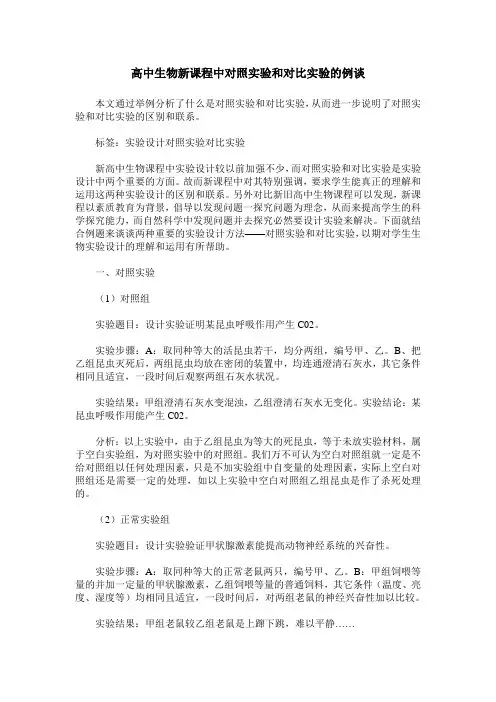
高中生物新课程中对照实验和对比实验的例谈本文通过举例分析了什么是对照实验和对比实验,从而进一步说明了对照实验和对比实验的区别和联系。
标签:实验设计对照实验对比实验新高中生物课程中实验设计较以前加强不少,而对照实验和对比实验是实验设计中两个重要的方面。
故而新课程中对其特别强调,要求学生能真正的理解和运用这两种实验设计的区别和联系。
另外对比新旧高中生物课程可以发现,新课程以素质教育为背景,倡导以发现问题一探究问题为理念,从而来提高学生的科学探究能力,而自然科学中发现问题并去探究必然要设计实验来解决。
下面就结合例题来谈谈两种重要的实验设计方法——对照实验和对比实验,以期对学生生物实验设计的理解和运用有所帮助。
一、对照实验(1)对照组实验题目:设计实验证明某昆虫呼吸作用产生C02。
实验步骤:A:取同种等大的活昆虫若干,均分两组,编号甲、乙。
B、把乙组昆虫灭死后,两组昆虫均放在密闭的装置中,均连通澄清石灰水,其它条件相同且适宜,一段时间后观察两组石灰水状况。
实验结果:甲组澄清石灰水变混浊,乙组澄清石灰水无变化。
实验结论:某昆虫呼吸作用能产生C02。
分析:以上实验中,由于乙组昆虫为等大的死昆虫,等于未放实验材料,属于空白实验组,为对照实验中的对照组。
我们万不可认为空白对照组就一定是不给对照组以任何处理因素,只是不加实验组中自变量的处理因素,实际上空白对照组还是需要一定的处理,如以上实验中空白对照组乙组昆虫是作了杀死处理的。
(2)正常实验组实验题目:设计实验验证甲状腺激素能提高动物神经系统的兴奋性。
实验步骤:A:取同种等大的正常老鼠两只,编号甲、乙。
B:甲组饲喂等量的并加一定量的甲状腺激素,乙组饲喂等量的普通饲料,其它条件(温度、亮度、湿度等)均相同且适宜,一段时间后,对两组老鼠的神经兴奋性加以比较。
实验结果:甲组老鼠较乙组老鼠是上蹿下跳,难以平静……实验结论:甲状腺激素能提高动物神经系统的兴奋性。
分析:以上实验中,由于乙组老鼠没有饲喂甲状腺激素,但实验前也知道该老鼠的一切生理正常,包括神经的兴奋性,故为正常实验组,为对照实验的对照组。

高中生物对照实验和对比实验的比较作者:薛春岩来源:《神州·上旬刊》2017年第01期对照实验和对比实验一直以来都是高中生物学实验中的难解难分的问题,学生对此容易困惑、混淆。
那么这两者之间到底有什么区别和联系呢?把通过对生物实验的分析总结出的结果和大家分享。
一、对照实验1.对照实验概念如果两组实验中,除了一个因素不同以外,其余因素都相同,那么这两组实验称为对照实验。
对照实验一般要设置对照组和实验组。
对照组和实验组要依据研究的问题和作出的假设来确定,有时候研究的问题和作出的假设改变了,对照组和实验组有可能会发生对换。
一般来说,保持原有状态的组作为对照组,人为改变条件的组作为实验组;又或者是已知实验结果的组作为对照组,未知实验结果的组作为实验组。
2. 对照实验一般都有对照组,只有一个变量在中学教学的层面上,可以将对照实验分为三种①空白对照,如加入等量的清水、蒸馏水或生理盐水;②自身对照,如研究动物的内分泌腺时,先摘除内分泌腺体,一段时间后再移入其腺体或补充一定量的相关激素,以观察生物自身实验前与实验后情况的变化;③条件对照,如特意控制一定的可以预知结果的自变量因素,使实验结果更加令人信服。
例如:人教版普通高中课程标准实验教科书《生物》必修1第79页,是“比较过氧化氢在不同条件下分解”的实验。
该实验设置了4支试管,条件分别是:1号不作任何处理,2号水浴加热,3号、4号分别滴加等量的三氯化铁溶液和新鲜的肝脏研磨液,其它条件一律相同。
实验下方的资料栏说:“除了一个因素以外,其余因素都保持不变的实验叫做对照实验。
”也就是说,只要保持了单一变量,无论是同一实验对象的前后纵比,还是若干实验对象之间的相互横比,都在对照实验范围之列。
资料还说:“对照实验一般要设置对照组和实验组,上述实验中的1号试管就是对照组,2号、3号和4号试管就是实验组。
”因此,根据以上理论基础,再结合其它实验处理条件的分析,不难看出:对照实验就是保持了单一变量的两组以上实验,一般要设置对照组和实验组。
![[实验微课3] 辨别“对比实验与对照实验” 2021版高考生物(山东)一轮复习](https://uimg.taocdn.com/a7d327606294dd88d0d26b89.webp)
[实验微课3] 辨别“对比实验与对照实验”1.对比实验及特点分析(1)含义:如果并不知道两组(或多组)实验中的自变量对实验结果所造成的影响,需要通过实验来进行确定。
此时就可以称这些实验为对比实验,对比实验也可称为相互对照实验。
(2)举例:①在美国科学家鲁宾和卡门的有关光合作用的同位素实验中,当时他们并不能确定氧气中的氧元素是来自二氧化碳分子还是水分子中的氧,因此,设计的实验就是分别标记二氧化碳中的氧元素和水中的氧元素,从实验结果中进行判断和确定。
此时,就不能简单地分辨谁是实验组,谁是对照组,只能将它们看作是相互对照或者对比实验,因此,在某些实验中对比实验也可以称为判决性实验。
噬菌体作为实验材料,利用放射性同位素标记技术,证明DNA②1952年,赫尔希和蔡斯以T2是遗传物质。
他们用35S和32P分别标记噬菌体的蛋白质外壳和DNA分子,这就是一组对比实验(相互对照),也是一个判决性实验。
③中学生物学教学中的对比实验有很多,如探究某种酶的最适宜温度和pH,质壁分离实验中探究洋葱鳞片叶表皮细胞的细胞液的大致浓度,等等。
2.对照实验及其类型分析(1)含义:如果只有一组实验,不足以说明该变量是影响实验结果的唯一因素,这时,需要设置一个未施加这种因素(自变量)而已知的实验结果作为对照,以明确这种因素所起的作用。
因此,通常把经过控制处理的一组(或者未知实验结果的一组)称为实验组,而将未经过处理的一组(自然状态下或者已知实验结果的一组)称为对照组。
(2)类型:①空白对照对照组为不作任何处理的对象组。
这里的不作处理,并非什么因素都不给予,而是针对实验所要研究的因素不给予,以体现实验因素的有无对实验结果的影响。
如“探究影响酶活性的条件”实验中:{1号试管加1mL蒸馏水(空白对照组) 2号试管加1mL盐酸溶液(实验组) 3号试管加1mL NaOH溶液(实验组)②自身对照实验与对照在同一个对象上进行,不另设对照组。
如“探究植物细胞的吸水和失水”实验,即是典型的自身对照——实验处理前的对象状况为对照组,实验处理后的对象变化为实验组。
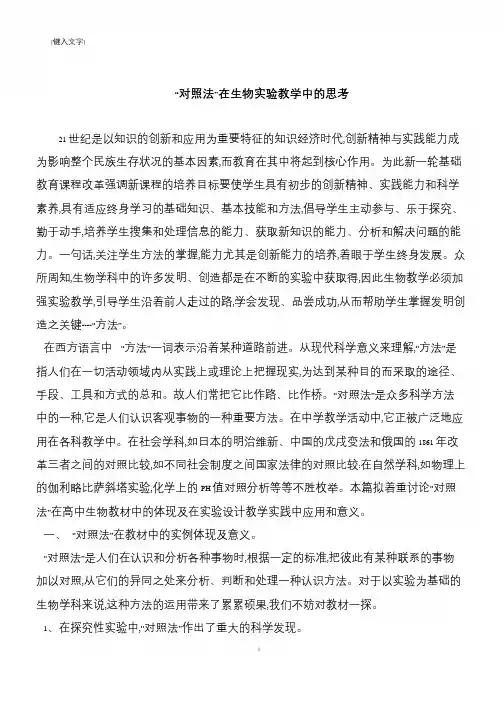
“对照法”在生物实验教学中的思考21 世纪是以知识的创新和应用为重要特征的知识经济时代,创新精神与实践能力成为影响整个民族生存状况的基本因素,而教育在其中将起到核心作用。
为此新一轮基础教育课程改革强调新课程的培养目标要使学生具有初步的创新精神、实践能力和科学素养,具有适应终身学习的基础知识、基本技能和方法,倡导学生主动参与、乐于探究、勤于动手,培养学生搜集和处理信息的能力、获取新知识的能力、分析和解决问题的能力。
一句话,关注学生方法的掌握,能力尤其是创新能力的培养,着眼于学生终身发展。
众所周知,生物学科中的许多发明、创造都是在不断的实验中获取得,因此生物教学必须加强实验教学,引导学生沿着前人走过的路,学会发现、品尝成功,从而帮助学生掌握发明创造之关键----“方法”。
在西方语言中“方法”一词表示沿着某种道路前进。
从现代科学意义来理解,“方法”是指人们在一切活动领域内从实践上或理论上把握现实,为达到某种目的而采取的途径、手段、工具和方式的总和。
故人们常把它比作路、比作桥。
“对照法”是众多科学方法中的一种,它是人们认识客观事物的一种重要方法。
在中学教学活动中,它正被广泛地应用在各科教学中。
在社会学科,如日本的明治维新、中国的戊戌变法和俄国的1861 年改革三者之间的对照比较,如不同社会制度之间国家法律的对照比较:在自然学科,如物理上的伽利略比萨斜塔实验,化学上的PH 值对照分析等等不胜枚举。
本篇拟着重讨论“对照法”在高中生物教材中的体现及在实验设计教学实践中应用和意义。
一、“对照法”在教材中的实例体现及意义。
“对照法”是人们在认识和分析各种事物时,根据一定的标准,把彼此有某种联系的事物加以对照,从它们的异同之处来分析、判断和处理一种认识方法。
对于以实验为基础的生物学科来说,这种方法的运用带来了累累硕果,我们不妨对教材一探。
1、在探究性实验中,“对照法”作出了重大的科学发现。
生长素的发现是历经数十年的发现性实验,它以1880 年达尔文的研究为开始,以1934 年荷兰科学家郭葛对生长素的分离鉴定为告一段落。
高中生物新课程中对照实验和对比实验的例谈(A case study of controlled experiment and comparative experiment in new biology course in Senior High School)A case study of controlled experiment and comparative experiment in new biology course in Senior High SchoolWang Qiong (Feidong No.1 middle school, Anhui 231600)[Abstract] this paper gives an example to analyze what is a contrast experiment and a contrast experiment, thus further explaining the difference and connection between the contrast experiment and the contrast experiment.[Key words] experiment design, contrast experiment, contrast experiment.In the biology curriculum of new senior high school, the experimental design is much better than before, while contrast experiment and contrast experiment are two important aspects of experiment design. Therefore, the new curriculum emphasizes on it and requires students to really understand and apply the differences and connections between the two experimental designs. The comparison between old and new high school biology curriculum can be found, the new curriculum in the background of quality education, advocate to find problems on the concept, so as to improve the students' ability of scientific research, natural science and find out the problems and to explore the necessary to design experiments to solve. Here is an example to talk about two important experimental design methods -- control experiment and contrast experiment, in order to helpstudents understand and apply biological experiment design.1. Control experiments1.1 control group: control experiment, two groups of experiments, one blank experimental group or normal experimental group or the experimental group known as the control group.1.2.1 example[experimental] experimental topic: design experiments prove that an insect respiratory effects produce CO2.Experimental procedure:A: take the same kind of live insects and divide them into two groups.After B and the killing of group B insects, two groups of insects were placed in airtight devices, all communicated with clarified lime water. The other conditions were the same and suitable. After a period of time, the two groups of lime water were observed.Results: the first clear limewater turbid, group B clarify lime had no change.Experimental results: an insect can produce CO2 by respiration.Analysis: in the above experiments, because the group B insectswere equal dead insects, which were equal to the experimental materials, the experimental group was the blank group, and the control group. We don't think it is not a blank control group to the control group in any processing factors, treatment factors just don't add variables in the experimental group, blank control group actually still need some treatment, such as blank control group group B in the above experiment is made to kill insects processing.[experimental group] experimental topic: design experiments prove that thyroid hormone can improve the excitability of animal nervous system.Experimental procedure: A: take two normal rats of equal size, number two, B and B.B: the first feeding amount and add a certain amount of thyroid hormone, normal diet group was fed with B, other conditions (temperature, humidity, brightness, etc.) are the same and appropriate, after a period of time, to compare nerve excitability in two groups of mice.Results: the group of mice compared with group B mice is jumping up and down, it is difficult to calm......Conclusion: thyroid hormone can improve the excitability of animal nervous system.Analysis: the above experiment, the group B rats not fed thyroid hormone, but also know everything before the experiment the rats of normal physiology, including nerve excitability, thenormal experimental group, control group control experiment.[experimental results] experimental topic: design experiments to verify that thyroid gland can affect the development of young animals.Experimental procedure: A: take two rats of the same kind and size;B: a thyroid gland was removed, B was not removed, other living conditions were the same and suitable for a period of time. The development of the two young rats was compared.Results: the first stop in growth, while group B rats in normal growth and development.Conclusion: thyroid gland gland can affect (promote) the development of young animals.Analysis: in the above experiments, because the young rats did not remove the thyroid gland, which itself is a normal development, known as the experimental results of the experimental group, so as the control of the experimental group.Here it is worth more than normal: the experimental group (without thyroid hormone) and the known experimental results in the experimental group (without resection of the thyroid gland), experimental verification is understood as independent variables per capita as the blank control, is justified.1.3 experimental group: Based on the control group to do an experiment, and draw a scientific conclusion, generally unknown experimental results of the experimental group, in general, is artificially processed the independent variables of the experimental group.1.3.1 for example, in the example above (1.2.1) in group A were put live insects, resection of the thyroid and thyroid hormone fed feed, were the experimental group treated with artificial variables, as the experimental group, no longer.2 、 contrast experiment2.1 definition: set up two or more than two experimental groups, by comparing the results to explore, explore the relationship between a certain factor and the experimental object, generally applicable to inquiry experiments.2.2 understand: a comparative experiment is refers to the comparison between experimental results, is a parallel relationship between experimental groups, no significant difference between control group and experimental group between group and group, if the specified one as the experimental group, the other group was the control group at the same time, the group can also be the control group group, the contrast experiment and the category than the control experiment, because the contrast between the two groups in each experiment any is actually a control experiment, because between the two groups is a different factors (independent variables). Therefore, some people call the contrast experiment a reciprocal contrast experiment.2.3 examples: experimental topic: design experiments to explore the appropriate concentration of willow cuttings rooting solution.Experimental procedure: A prepared the mass percent content of 0.1%, 0.2%, 0.3%, 0.4%, 0.5% concentration of auxin dilution solution.B, soaking the same length and thick willow roots for three times in each long life dilution solution, and observing the rooting status of each willow branch for a period of time.The results showed that the average number of rooting was the highest in the 0.2% groups.Conclusion: 0.2% auxin solution can promote the rooting of willow cuttings.2.4 analysis: in 0.2% of the auxin solution, willow cuttings rooting most, but if there is no other group of control, we can not say that 0.2% of auxin solution is above the concentration of auxin solution in the most appropriate concentration. Of course, without 0.2% of auxin solution as a control, we can not say that other auxin solutions are not the best concentration, so the parallel relationship between the experimental groups in the comparative experiment is parallel. It is worth noting here is a concentration gradient, pH gradient, temperature gradient in the experiment design, the appropriate gradient range to determine the precise design of the smaller gradient, such as auxin solution presented above 0.2% could promoterooting of switchgrass, we can in a concentration of 0.2% or less concentration gradient design to measure, such as 0.18%, 0.19%, 0.20%, 0.21%, 0.22%...... There is no best, only better. In addition, compared with the gradient experiment design in the experiment, we should design more than three groups at least.Finally, it is also clear that not all experimental designs need to be designed as a control group, and some factorial experiments do not require the control group, such as Mendel's genetic law, and the experiment does not require a control group.To sum up, we know that the experiment design is important and difficult knowledge of traditional biology teaching in senior high school, a kind of questions in recent years in the college entrance examination is compulsory, so students still need to understand the difference and connection between the experimental and control experiments. It is helpful to improve the ability of experiment design by means of example analysis, comparison experiment and contrast experiment.ReferenceBiology (ordinary high school curriculum standards, experimental textbooks, compulsory 1), people's education press, Zhu Zhengwei, Zhao Zhanliang editor in chief.Interpretation of experimental design principles in the new biology curriculum of senior high schoolWang Qiong (Feidong No.1 middle school, Anhui 231600)[Abstract] combining the subject characteristics of the new curriculum of biology in senior high school, this paper interprets the six principles that should be followed in the experiment design by means of concepts and examples. Accurate grasp of the principles of experimental design is the premise of the conclusion of scientific experiments.Interpretation of the principles of experimental designA new round of basic education curriculum reform has a profound impact on Teachers' thinking patterns and educational ideas. Biological science, as a natural science, speaks with natural facts. It always advocates inquiry learning, especially the new curriculum standard, which pays more attention to the development of students' scientific inquiry ability. Through the experimental design to cultivate students' scientific inquiry ability, comprehensive practical ability, knowledge application ability and innovation ability, is a very good means. The following is the author through the teaching practice of experimental design required to follow the six principles of interpretation.1, the control principleIn the experiment design, usually set in the control group, the intervention or control subjects to eliminate or reduce the error in the experiment of differential treatment factors (independent variables) with non treatment factors (independent variables) difference. Many control methods canbe used in the experimental design, in addition to the standard control, self control and mutual control, usually using control principle, which is called the control group any processing factors, it is worth emphasizing that, without any treatment to the control group, the experimental group and the other factor is relative, in fact the control group still need to do some the processing, processing factors only without the experimental group.The principle of comparison is the first consideration in experimental design, because there is no comparison, and the conclusion drawn from the single experiment is one-sided and can not explain any problem. For example, to verify that an oral preparation can be used to inhibit the growth of cancer cells, if only to some cancer mice oral preparation to observe the results, so that it is isolated results.Because people can think so: the preparation is to promote the growth of cancer cells, or inhibit the growth of cancer cells, or the growth of cancer cells have no stimulative effect, nor inhibition. If there is another group of the same cancer mice oral preparation (oral saline), at the end of the two groups of mice appear different results were compared, the conclusion is convincing.2, the principle of single factor variablesThe principle of single factor variable, that is, control other factors unchanged, only change one of the factors (independent variables), observe its impact on the experimental results. In addition to the experimental factors to be dealt withthroughout the experiment, other experimental conditions are required to be consistent.The single variable principle is as important as the comparison principle, and it is the core principle that makes the experimental results convincing and must be observed. In order to follow the single factor principle accurately, we usually do the following design according to the following procedures.First of all, define the topic of experimental design. Some students in the reading material test questions often found in the process of teaching (not directly given experimental design, but the experimental design in information reading and chimeric to experimental materials), in the experimental subject did not find the case, just start writing up, which is equivalent to Tomb-sweeping Day grave worship. "The cemetery not found" (subject) and "cry", so that the results of the experiment are as can be imagined, remote from the subject.Secondly, in determining the subject of the experiment, we must find the theme of the experimental design in the subject, that is, the object that the experiment should explore or verify. If he did not find the theme, it is difficult to determine the independent variables, there is no way to follow the principle of the single factor variable, which is equal to theTomb-sweeping Day grave worship, to find a "graveyard", but did not find the "grave" (theme experimental subject) "cry", the experimental results obtained and the objective real results what is the.Finally, after defining the experimental topic, the principleof the single variable is followed by the principle of whether the subject (independent variable) has or not dealt with or not dealt with, which captures the backbone and lifeblood of the experimental design. For example: in order to verify whether insulin can reduce blood sugar, the problem here is clear, and the theme is the amount of insulin, insulin in the experimental group and the control group in the US is determined with and without the theme, but in reality, some students designed to do different insulin concentration gradient, so the conclusion suitable concentration of insulin is to reduce blood sugar. Instead of verifying that insulin lowers blood sugar levels, this is not the subject of the experiment. Here I would like to put forward some questions in the experiment is more than one theme, such as photosynthesis and chloroplast verification need light, two theme here are light and chloroplasts, should be dealt with separately these two themes, generally set up a group as the control group in the two experimental groups were set to no light and no theme the theme of chloroplast.3, the principle of portabilityThe principle of feasibility refers to the materials, equipment and practices needed for the experiment, so as to meet the objective facts. For example, verify the root to back of and stem growth is caused by gravity, this experiment is the subject of gravity, according to the theme of some students put in groups of two plants were placed in equivalent gravity environment, another group was placed in the weightless environment, only the single factor variable for this design is yes, but in the real life of a middle school students, how to put the plants in the zero gravity environment is difficultto achieve, if the hand is difficult to achieve in space, on the other hand, it is difficult to control space and other factors. So in the feasibility under the guidance of the principle, to another idea, to put each plant morphological changes where they in the same geographical conditions (horizontal, vertical display, display tilting display etc.), through the observation of the experimental results, the experimental results are accurate.4, random principleRandom variation principle in experimental design, refers to the study sample was randomly selected in the population, is the significance of this: one is that it can eliminate or reduce the system error, the test has universal significance significant; two is to balance the various conditions to avoid the deviation of the experimental results. The random principle in scientific research to some macro reflected in the obvious, such as the investigation of a certain period of time in a certain area of the male to female ratio, a survey of plants in grassland ecosystems and species quantity by sampling method.5, the principle of parallel repetition:The principle of equal repetition, that is, controlling the magnitude of a factor, repeating the experiment under the same conditions, and observing the extent to which it affects the results of the experiment.The principle of parallel repetition is understood in two ways.First, design experiments must be repeated; in other words, others can repeat the experiment, which is a sign of science.A review of the classical experiments in the history of biological science,Such as Hershey, Zeiss and other people's phage infection bacteria experiments, Mendel's exploration of the two major genetic laws, experiments, etc., are able to repeat later generations, and the feasibility of the principle is corresponding. The second is the stochastic principle, which requires random sampling of the sample, which can offset the bias caused by non processing factors to a considerable extent. But it can not eliminate all its influence, and the principle of parallel repetition is put forward to solve the problem. For example: validation of suitable growth hormone concentration can promote the development of individual young animal, in the experimental group and the control group in the number of all the tadpole is not random one or a few, but random dozens of above, this would eliminate one or two individual tadpole vulnerability experiment of large deviation caused by the accident factor.6, the principle of saving raw materialsSaving raw materials means that in the experimental design process, without affecting the conclusion of scientific experiments, we should try to save the experimental materials, and make sure that we live within our means".The principle of saving raw materials surface looks a bit inconsistent, and the parallel repetition principle in fact,such as above with tadpoles as the experimental material, we each can have only one or a few, but can not be used only for tens of thousands of, with spinal afferent nerve reflex arc in frog proof and spread the nerve function (the college entrance examination in 2003 the content, we can use) own control measures, the premise with normal reflex function in complete reflex arc, then cut off the afferent and efferent nerve to verify them on excitatory afferent and efferent function, the entire experiment with a frog, but does not need to according to the afferent and efferent nerve of the two independent variables to design two experimental groups respectively, plus a control group, with three frogs, however the frog is a protected animal, not abuse.The following six principles are followed in the experimental design, and they have a certain order in the experimental design. But there is no priority in following the dynamics. A scientific experiment design must follow these principles, and the relations between these principles are inseparable, complement each other, complement each other.Reference material:1, the "biological" (experimental high school curriculum standard textbook, compulsory compulsory 1, 2) people's education press, Zhu Zhengwei, Zhao Zhanliang.2, "high school biology teaching material whole solution", Tianjin people's publishing house, Wu Junmin editor in chiefModify time: Sun Apr 13 21:34:30 Greenwich standard time +08002014------。
高中生物对比试验与对照试验举例说明对照bai实验和对比实du验在高中答文库wenku.baidu.***/link?url=kybvcquk-cphdw1zgae1oakdqnybdilmfya8fpgydbw-lbwz9ngrzgo5guu1y7cgphvw36e-qnyyx42d1zyxyny2ooyvhivrul2rlkustpy对照试验:除复了单一变数以外制,其他条件都保持bai一致。
du验证酶的高效性:1号试zhi管:2毫升dao双氧水2号试管: 2毫升双氧水,再滴加3滴肝脏研磨液3号试管:2毫升双氧水,3滴三氯化铁溶液1号不做处理,2号、3号分别与1号对照。
(空白对照)2号、3号作对比,说明酶具有高效性。
(对比酶、无机催化剂,说明酶具有高效性。
生物:对比实验和对照实验的区别?不做任何处理的是对照组,说明正常情况下他是什么状态做相关处理,满足研究专因素或者去除相关因属素,是实验组通过两组对比说明研究因素对实验结果的影响对比试验应该是相互对照的意思,没有空白对照,只是在相关研究因素上做了多个处理,比如:我们想研究温度对酶活性的影响,我们分别在10摄氏度,20,30,40,50,60,70,不同的温度下做了同样的实验操作,只是温度不同,所以各实验间就形成了对比实验。
对照试验与对比试验的区别二者区别:1、变数不同对照试验是只有一个条件不同,其他条件都相同。
对比试验是将两个研究内容相似的试验进行对比。
设定两个或两个以上的实验组,通过对结果的比较分析,来**某种因素与实验物件的关系,这样的实验叫做对比试验。
2、实验设计不同可以将对照实验分为空白对照,如加入等量的清水、蒸馏水或生理盐水;自身对照,如研究动物的内分泌腺时,先摘除内分泌腺体,一段时间后再移入其腺体或补充一定量的相关激素,以观察生物自身实验前与实验后情况的变化;条件对照,如特意控制一定的可以预知结果的自变数因素,使实验结果更加令人信服,上述蝌蚪实验中的第三组就能基本说明问题,等等。
浅谈高中生物教学中对照实验和对比实验
许淑萍
【期刊名称】《数理化解题研究:高中版》
【年(卷),期】2014(000)002
【摘要】新高中生物课程中实验设计较以前加强不少,而对照实验和对比实验是实验设计中两个重要的方面.故而新课程中对其特别强调,要求学生能真正的理解和运用这两种实验设计的区别和联系.另外对比新旧高中生物课程可以发现,新课程以素质教育为背景,倡导以发现问题——探究问题为理念,从而来提高学生的科学探究能力,而自然科学中发现问题并去探究必然要设计实验来解决.下面就结合例题来谈谈两种重要的实验设计方法——对照实验和对比实验,以期对学生生物实验设计的理解和运用有所帮助.一、对照实验1.
【总页数】2页(P60-61)
【作者】许淑萍
【作者单位】新疆博乐农五师高级中学,833400
【正文语种】中文
【中图分类】G633.91
【相关文献】
1.浅谈高中生物的对照实验与解实验题 [J], 黄平;
2.浅谈初中物理教学中设计的自身对照实验 [J], 李伟报
3.高中生物实验教学中几种教学模式的对比分析 [J], 于智勇;罗金;刘巧平;吴文展;
张玉;林颖韬
4.高中生物对照实验和对比实验的比较 [J], 薛春岩
5.浅谈高中生物对照实验 [J], 罗庆庆
因版权原因,仅展示原文概要,查看原文内容请购买。
高中生物科学方法(4)对照实验与对比实验区分1.对比实验及特点分析(1)含义如果并不知道两组(或多组)实验中的自变量对实验结果所造成的影响,需要通过实验来进行确定。
此时就可以称这些实验为对比实验,对比实验也可称为相互对照实验。
(2)举例①在有关光合作用的同位素实验中,不能确定氧气中的氧元素是来自二氧化碳分子中的氧还是水分子中的氧时,设计的实验就是分别标记二氧化碳中的氧元素和水分子中的氧元素,根据实验结果进行判断和确定。
此时,就不能将两组实验分为实验组和对照组,只能将它们看作是相互对照或者对比实验,因此,在某些实验中对比实验也可以称为判决性实验。
②高中生物学中的对比实验有很多,如探究某种酶的最适温度和pH,质壁分离实验中探究洋葱鳞片叶表皮细胞的细胞液的大致浓度,探究酵母菌细胞呼吸的方式,噬菌体侵染细菌实验等。
2.对比实验的设计思路3.对比实验与对照实验的关系如果人们不知道温度对某种植物种子萌发的影响,此时设计一系列的实验条件进行研究,这就是对比实验,从对比实验中可以确定该种子萌发的最适温度;如果现在人们已经知道了上述种子萌发的最适温度,还想研究其他温度对该种子萌发的影响,此时设计的实验就是对照实验。
1.对比实验是科学探究中常用的方法之一。
下列有关叙述错误的是()A.探究酵母菌细胞呼吸的方式运用了对比实验B.对比实验中每个实验组的结果通常都是事先未知的C.对比实验往往没有对照组,而是设置两个或两个以上的实验组D.对比实验中因变量可以用多种指标表示,无关变量只需相同即可解析:探究酵母菌细胞呼吸的方式运用了对比实验法,A正确;对比实验中每个实验组的结果通常是事先未知的,通过实验结果的对比来说明问题,B正确;对比实验往往没有对照组,而是设置两个或两个以上的实验组相互对照,C正确;对比实验的因变量可以用多种指标表示,无关变量需相同且适宜,D错误。
答案:D2.在探究实验的设计过程中,往往要设置对照实验,下列有关叙述正确的是() A.只能设置两个实验组,互为对照实验B.在“探究酵母菌细胞呼吸的方式”的实验中,产物不同,即酒精和CO2构成对照实验C.进行对照实验是为了探究某种因素与实验对象的关系D.只要实验现象明显,有无对照实验对实验结论没有影响解析:进行对照实验是为了探究某种因素与实验对象的关系,根据需要可设置两个或两个以上的实验组,A错误,C正确;在“探究酵母菌细胞呼吸的方式”的实验中,反应条件即有氧和无氧构成对照,而非产物构成对照,B错误;只有与对照实验做比较,才能准确说明某种因素与实验对象的关系,若没有对照实验,得出的结论往往是不科学的、不严谨的,D错误。
对照论文:浅谈高中生物对照实验摘要:实验设计题已成为高考实验题的重点,对照实验的设计是实验题中最常见的。
对照实验可以更加明确地排除无关变量对实验结果的影响,这样可以增加实验结果的说服力。
对照实验在高中生物实验中占有重要的地位,本文论述了对照实验的概念、好处、类型、对照实验的设计。
关键词:对照;实验:原则在高中生物教学中对实验设计过程中应遵循的原则教材中并没有作具体的概括和总结,这就要学生在学习课本知识的过程中认真体会教材中的每个学生实验,思考实验者的设计思路,迁移知识技能。
教师明确掌握生物学实验设计的基本原则和方法,才能设计出一个完整、严谨的实验方案,也才能科学地分析和解释实验结果、推导结论。
一、什么是对照实验对照实验是指除控制因素外,其他条件与被对照实验要保持一致。
这样就可以保证无关变量对所研究实验无影响,使得结论变得简单明了。
二、对照实验的组成对照实验通常包括实验组和对照组,至于哪个作为实验组,哪个作为对照组,一般是随机决定。
从理论上说实验组与对照组的无关变量影响一定要相同,这样实验组与对照组两者之差异,就可以认定是来自变量的影响,这样实验结果才有可信度。
三、对照实验的好处不同的实验因素可以引起同一种实验结果,所以,必须要有严格的对照,这样所设计的实验才具有更强的说服力,就可以保证无关变量对所研究实验无影响,使得结论清楚且简单。
所以大多数实验,尤其是生理类实验往往都要设置相应的对照实验。
预测实验结果:若为验证性实验,则结果只有一个;若为探究实验,则应分情况讨论。
四、对照实验的类型本文对以下三类对照类型做一个论述,各种对照实验中哪个作为实验组,哪个作为对照组,应具体情况具体分析。
1.空白对照(1)概述空白对照组是指除给予范围的实验因素外,不给予研究的实验因素处理。
探究某种实验因素的有无对实验结果的直接影响,明显的对比出实验组的实验因素与实验结果的对应关系。
(2)典例分析(3)注意事项①实验设计一定要分组进行。
高中生物新课程中对照实验和对比实验的例谈
摘要:本文通过举例分析了什么是对照实验和对比实验,从而进一步说明了对照实验和对比实验的区别和联系。
关键词:实验设计对比实验对照实验
新高中生物课程中实验设计较以前加强不少,而对照实验和对比实验是实验设计中两个重要的方面。
故而新课程中对其特别强调,要求学生能真正的理解和运用这两种实验设计的区别和联系。
另外对比新旧高中生物课程可以发现,新课程以素质教育为背景,倡导以发现问题一探究问题为理念,从而来提高学生的科学探究能力,而自然科学中发现问题并去探究必然要设计实验来解决。
下面就结合例题来谈谈两种重要的实验设计方法――对照实验和对比实验,以期对学生生物实验设计的理解和运用有所帮助。
一、对照实验
(1)对照组
实验题目:设计实验证明某昆虫呼吸作用产生C02。
实验步骤:A:取同种等大的活昆虫若干,均分两组,编号甲、乙。
B、把乙组昆虫灭死后,两组昆虫均放在密闭的装置中,均连通澄清石灰水,其它条件相同且适宜,一段时间后观察两组石灰水状况。
实验结果:甲组澄清石灰水变混浊,乙组澄清石灰水无变化。
实验结论:某昆虫呼吸作用能产生C02。
分析:以上实验中,由于乙组昆虫为等大的死昆虫,等于未放实验材料,属于空白实验组,为对照实验中的对照组。
我们万不可认为空白对照组就一定是不给对照组以任何处理因素,只是不加实验组中自变量的处理因素,实际上空白对照组还是需要一定的处理,如以上实验中空白对照组乙组昆虫是作了杀死处理的。
(2)正常实验组
实验题目:设计实验验证甲状腺激素能提高动物神经系统的兴奋性。
实验步骤:A:取同种等大的正常老鼠两只,编号甲、乙。
B:甲组饲喂等量的并加一定量的甲状腺激素,乙组饲喂等量的普通饲料,其它条件(温度、亮度、湿度等)均相同且适宜,一段时间后,对两组老鼠的神经兴奋性加以比较。
实验结果:甲组老鼠较乙组老鼠是上蹿下跳,难以平静……
实验结论:甲状腺激素能提高动物神经系统的兴奋性。
分析:以上实验中,由于乙组老鼠没有饲喂甲状腺激素,但实验前也知道该老鼠的一切生理正常,包括神经的兴奋性,故为正常实验组,为对照实验的对照组。
(3)已知实验结果组
实验题目:设计实验验证甲状腺腺体能影响动物幼小个体的发育。
实验步骤:A:取同种等大的幼鼠两只,编号甲、乙;B:甲去除甲状腺,乙不去除,其它生活条件相同且适宜,一段时间后比较两幼鼠发育状况。
实验结果:甲组幼鼠停止生长发育,而乙组幼鼠生长发育正常。
实验结论:甲状腺腺体能影响(促进)动物幼小个体的发育。
分析:以上实验中,由于幼鼠没有去除甲状腺,本身是能正常发育,为已知实验结果的实验组,故为对照实验中的对照组。
这里值得说明的是:以上正常实验组(未加甲状腺激素)和已知实验结果实验组(未切除甲状腺),就实验所需验证的自变量而言有人均理解为不作处理的空白对照,也是有道理的。
(4)实验组:以对照组为基础做一个实验而得出科学的结论,一般为未知实验结果的实验组,总体来说是经过人为处理了自变量的实验组。
二、对比实验
(1)定义:设置两个或两个以上的实验组,通过对比的结果来分析探索某种因素和实验对象的关系,一般适用于探究性实验。
(2)理解:对比实验是指实验结果之间相互比较,各组实验之间是平行关系,组和组之间没有明显的对照组和实验组之分,若指定其中一组为实验组,其它组则均为其对照组,同时该组也可以是其它组的对照组,对比实验和范畴比对照实验小,因为对比实验中每任何两组之间实际就是一个对照实验,因为两组之间也只是一个因素不同(自变量)。
因而又有人将对比实验称为相互对照实验。
(3)举例:实验题目:设计实验探究促进柳枝扦插生根的适宜浓度的生长素溶液。
实验步骤:A:配制质量百分含量分别为0.1%、0.2%、0.3%、0.4%、0.5%浓度的生长素稀释液。
B:在每一生长素稀释溶液中均浸泡同种等粗长的柳枝三根,一段时间观察每组柳枝的生根状况。
实验结果:0.2%组中柳枝生根的平均数最多。
实验结论:0.2%的生长素溶液能较好的促进柳枝扦插生根。
(4)分析:在0.2%的生长素溶液中柳枝扦插生根最多,但若没有其它组的对照,我们就不能说0.2%的生长素溶液是以上各浓度生长素溶液中最适宜浓度。
当然没有0.2%的生长素溶液作为对照,我们也不能说其它生长素溶液就不是最适宜的浓度,因而对比实验中各实验组之间是相互对照的平行关系。
这里值得注意是,关于浓度梯度,PH值梯度,温度梯度等的实验设计题,可以在适宜梯度范围内再设计更小梯度来更精确的测定,如以上得出0.2%的生长素溶液较好的促进柳枝扦插生根后,我们还可以再在0,2%浓度的左右设计更小浓度梯度来
测定,如0.18%、0.19%、0.20%、0.21%、0.22%……,真正做到没有最好,只有更好。
另外对比实验中的梯度实验设计,至少要设计三组以上,方有说明力。
最后还要明确的是,不是所有的实验设计均需要设计对照组,也有的析因实验设计中就不需要对照组,如孟德尔的遗传定律实验就无需对照组。
综上所述,我们知道实验设计是高中生物教学中传统的重难点知识,也是近些年来高考中必考的一种题型,因而还是需要学生理解对照实验和对比实验的区别和联系。
通过举例分析比较对照实验和对比实验,对实验设计能力的提高应该是有帮助的。